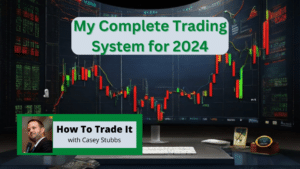Master the Vertical Option Strategy: Insights from a Real-Life Fighter Pilot

In this episode of “How to Trade It,” Casey Stubbs sits down with the founder of Top Gun Options, Matthew “Whiz” Buckley. The conversation kicks off with Whiz sharing his background of being in the Navy and how he transitioned to become a successful trader. Drawing parallels between military briefings and trading strategies, Whiz emphasizes the importance of being strategic and operational in addition to tactical. The two discuss Whiz’s famous vertical option strategy and what is involved in its execution.
Whiz explains how, as a fighter pilot, he applied the same procedures to trading, treating it as a form of combat where strategic thinking, tactics, and risk management play a crucial role. He highlights the significance of having a high-level strategy like the vertical option strategy, implementing supporting tactics, and contingency planning before executing a trade. You don’t want to miss it!
Subscribe to How To Trade It
Some show highlights include…
S-O-T Strategy and Red-Teaming:
- Introduces the S-O-T strategy – Strategic, Operational, and Tactical – emphasizing the importance of analyzing global events, understanding the operational landscape, and executing specific trades.
- Live trade briefs at Top Gun Options incorporate a red-teaming process, allowing traders to challenge and improve each other’s trade plans.
Value of Community in Trading:
- Draws parallels between military briefings and debriefs and the trading community, stressing the importance of learning from both successful and unsuccessful trades.
- Shares Whiz’s seven-step trade plan, including commit criteria and continuous evaluation of trade rationale.
Trade Plan, Discipline, and Risk Management:
- Highlights the significance of having a solid trade plan and the discipline to adhere to it.
- Emphasizes the need for traders to take responsibility for their decisions and introduces the 5% rule for position sizing to manage emotional distress from potential losses.
Shift in Trading Approach – Double Vertical Option Strategy:
- Describes Whiz’s shift from covered calls to options trading and introduces the double vertical option strategy.
- Explains the components of the double vertical option strategy, involving bear call spreads (credit spread) and bear put spreads (debit spread), providing a recent example of a bullish double vertical on the S&P 500.
Psychedelic Space and Healing Initiatives:
- Whiz shares his interest in the psychedelic space and its potential for healing, especially for veterans suffering from PTSD.
- Invites listeners to a free webinar on investing in the psychedelic sector, highlighting the dual benefits of potential financial gains and contributing to healing initiatives.
The interview touches on Whiz’s journey from being a self-taught trader to catching the attention of a major volatility arbitrage firm in Chicago. He shares insights into his approach to trading equity options, emphasizing the need for traders to minimize known risks and manage risk effectively.
The discussion delves into the S-O-T strategy – Strategic, Operational, and Tactical – where Whiz explains the importance of looking at global events, understanding the operational landscape, and then diving into specific trades. The live trade briefs at Top Gun Options incorporate a red-teaming process, allowing traders to challenge and improve each other’s trade plans.
Casey and Whiz discuss the value of community in trading, drawing parallels to military briefings and debriefs. They stress the importance of learning from both successful and unsuccessful trades, with Whiz sharing his seven-step trade plan that includes commit criteria and continuous evaluation of trade rationale.
Whiz highlights the significance of having a solid trade plan, the discipline to stick to it, and the need for traders to take responsibility for their decisions. Additionally, he emphasizes the importance of risk management for retail traders, suggesting a 5% rule for position sizing to avoid emotional distress in case of losses.
Whiz shares a shift in his trading approach, moving away from covered calls to focus on options. He introduces the concept of a double vertical option strategy, explaining how it involves two trades, a bear call spread (credit spread) and a bear put spread (debit spread), providing an example of a recent bullish double vertical on the S&P 500.
The discussion extends to the time commitment required for different trading strategies. Whiz mentions various model portfolios at Top Gun Options, including an accelerated retirement portfolio with longer-term trades and tactical trades executed during weekly options briefs. He emphasizes the importance of adapting to the current market conditions and avoiding trades when uncertainties, like major Fed announcements, are present. It is one thing to note that options are not the only way to trade you can also do Forex Trading and they have a unique tool called EA’s which help you trade on auto pilot.
Towards the end, Whiz delves into his interest in the psychedelic space, sharing personal experiences and advocating for the healing potential of psychedelic-assisted therapy, especially for veterans suffering from PTSD. He invites listeners to a free webinar on investing in the psychedelic sector, emphasizing the dual benefits of potential financial gains and contributing to healing initiatives.
Throughout the episode, Whiz provides valuable insights into trading strategies (including his vertical option strategy), risk management, and the evolving landscape of investment opportunities, showcasing a unique blend of financial expertise and a broader perspective on personal well-being and healing.
A vertical option strategy, also known as an options vertical spread, is a trading strategy involving the simultaneous buying and selling of options of the same type (either calls or puts) on the same underlying security but with different strike prices. The goal of a vertical spread is to profit from the relative movement of the underlying asset’s price within a specified range.
There are two main types of vertical options:
- Bullish Vertical Spread (Bull Call Spread):
- Components: Involves buying a call option with a lower strike price and simultaneously selling a call option with a higher strike price.
- Objective: Profits when the underlying asset’s price rises moderately. Limited profit potential but also limited risk.
- Bearish Vertical Spread (Bear Put Spread):
- Components: Involves buying a put option with a higher strike price and simultaneously selling a put option with a lower strike price.
- Objective: Profits when the underlying asset’s price falls moderately. Like the bull call spread, it has limited profit potential and limited risk.
In both cases, the vertical option strategy allows traders to manage risk by combining a long position (buying an option) with a short position (selling an option). The difference in strike prices determines the spread’s width, and this width represents the maximum potential loss.
Key characteristics of vertical spreads:
- Limited Risk: The maximum loss is known and capped at the initial cost of establishing the spread.
- Limited Profit: The maximum profit is also capped, typically occurring if the underlying asset’s price closes at or beyond the higher strike price (for a bull call spread) or at or below the lower strike price (for a bear put spread).
- Net Premium Paid or Received: Traders will either pay a net premium to establish the spread (bull call spread) or receive a net premium (bear put spread). The net premium is the cost of entering the trade.
A vertical option strategy is very popular for traders seeking a balance between risk and reward. They provide a way to express a directional view on an asset while managing potential losses. The effectiveness of a vertical spread depends on the accuracy of the trader’s market forecast and the chosen strike prices.
Post-Traumatic Stress Disorder (PTSD) can have profound effects on military personnel due to their exposure to traumatic and often life-threatening experiences during service. Here are several ways in which PTSD can impact military personnel:
- Flashbacks and Nightmares: Military personnel with PTSD may experience vivid and distressing flashbacks or nightmares related to combat situations or other traumatic events they witnessed or were a part of during their service.
- Hypervigilance: PTSD can lead to a heightened state of arousal, causing individuals to be constantly on edge and hyperalert. This hypervigilance is a survival mechanism that can interfere with daily life and make it challenging to relax or feel safe.
- Avoidance Behaviors: Those with PTSD may avoid situations, places, or activities that remind them of the traumatic events. This avoidance can lead to social isolation and impact the individual’s ability to engage in normal, everyday activities.
- Emotional Numbing: Military personnel with PTSD may experience emotional numbness or difficulty connecting with others emotionally. This emotional distance can strain relationships with family, friends, and colleagues.
- Irritability and Anger: PTSD can contribute to increased irritability, anger outbursts, and difficulty managing frustration. This can strain relationships and make it challenging to work collaboratively with others.
- Sleep Disturbances: Many individuals with PTSD, including military personnel, often struggle with sleep disturbances such as insomnia, night sweats, or nightmares. Poor sleep can exacerbate other symptoms and negatively impact overall well-being.
- Negative Changes in Cognition: PTSD can affect cognitive processes, leading to difficulties with concentration, memory, and decision-making. This can impact an individual’s ability to perform well at work or in daily tasks.
- Physical Health Issues: The chronic stress associated with PTSD can contribute to physical health problems, including cardiovascular issues, gastrointestinal problems, and a weakened immune system.
- Substance Abuse: Some individuals may turn to alcohol or drugs as a way to cope with the symptoms of PTSD, leading to an increased risk of substance abuse disorders.
It’s important to note that not everyone exposed to traumatic events in the military develops PTSD, and individuals may vary in their responses to trauma. Seeking professional help, such as therapy and counseling, is crucial for those experiencing symptoms of PTSD, as early intervention can significantly improve outcomes.
Resources Mentioned
Books by “Whiz”…available on Amazon
Connect With Matthew “Whiz” Buckley
- Website: https://topgunoptions.com/
- Website (non-profit): https://nofallenheroesfoundation.org/
- YouTube: https://www.youtube.com/channel/UCC-ooSZn3o1loFQBTp5Knyw
- Twitter: https://x.com/TopGunOptionsHQ
- Facebook: https://www.facebook.com/profile.php?id=100080715210829
- LinkedIn: https://www.linkedin.com/in/ematthewbuckley/
- Instagram: https://www.instagram.com/official_whizbuckley/
Connect With Casey Stubbs
- Website: https://tradingstrategyguides.com/
- Website: https://caseystubbs.com
- Website: https://globalproptrader.com/
- YouTube: https://www.youtube.com/TradingStrategyGuides
- YouTube: https://www.youtube.com/caseystubbs
- Twitter: https://www.twitter.com/caseystubbs
- Facebook: https://www.facebook.com/TradingStrategyGuides
- LinkedIn: https://www.linkedin.com/in/caseystubbs/
Subscribe to How To Trade It
Disclaimer: Trading carries a high level of risk, and may not be suitable for all investors. Before deciding to invest you should carefully consider your investment objectives, level of experience, and risk appetite. The possibility exists that you could sustain a loss of some or all of your initial investment. Therefore, you should not invest money that you cannot afford to lose. You should be aware of all the risks associated with foreign exchange trading, and seek advice from an independent financial advisor if you have any doubts.





